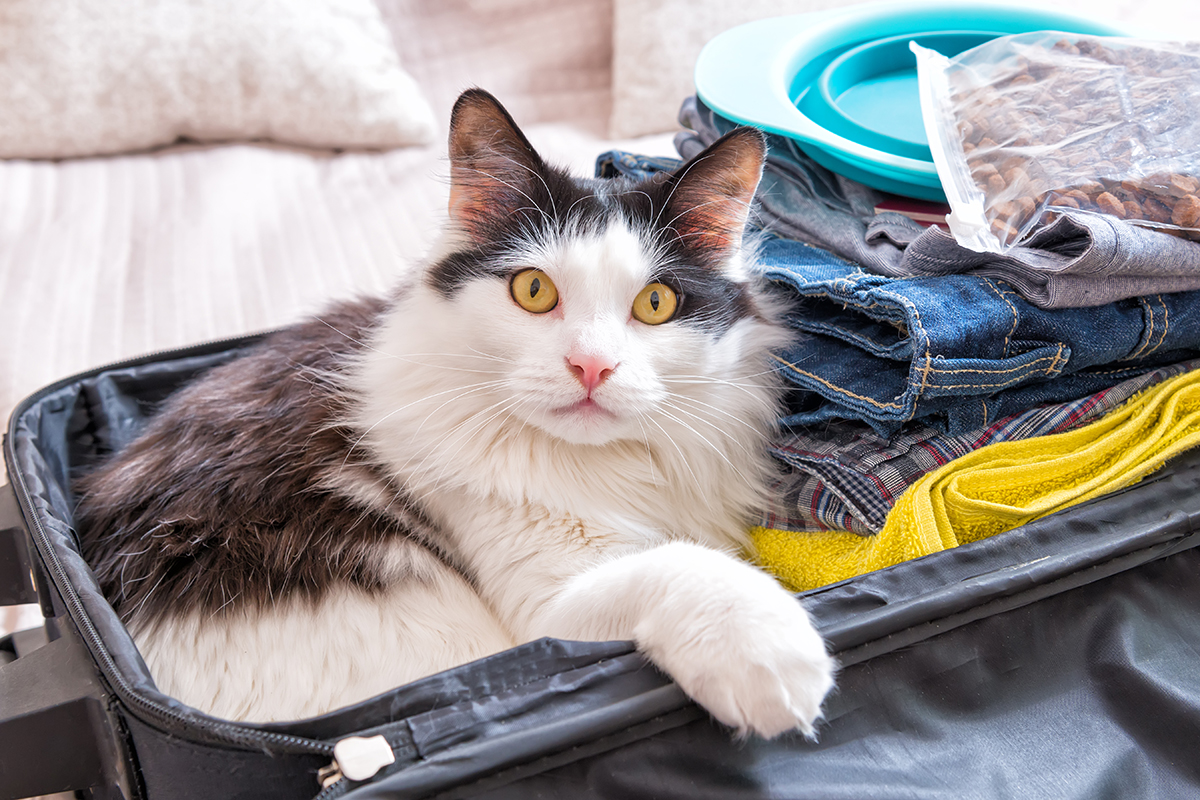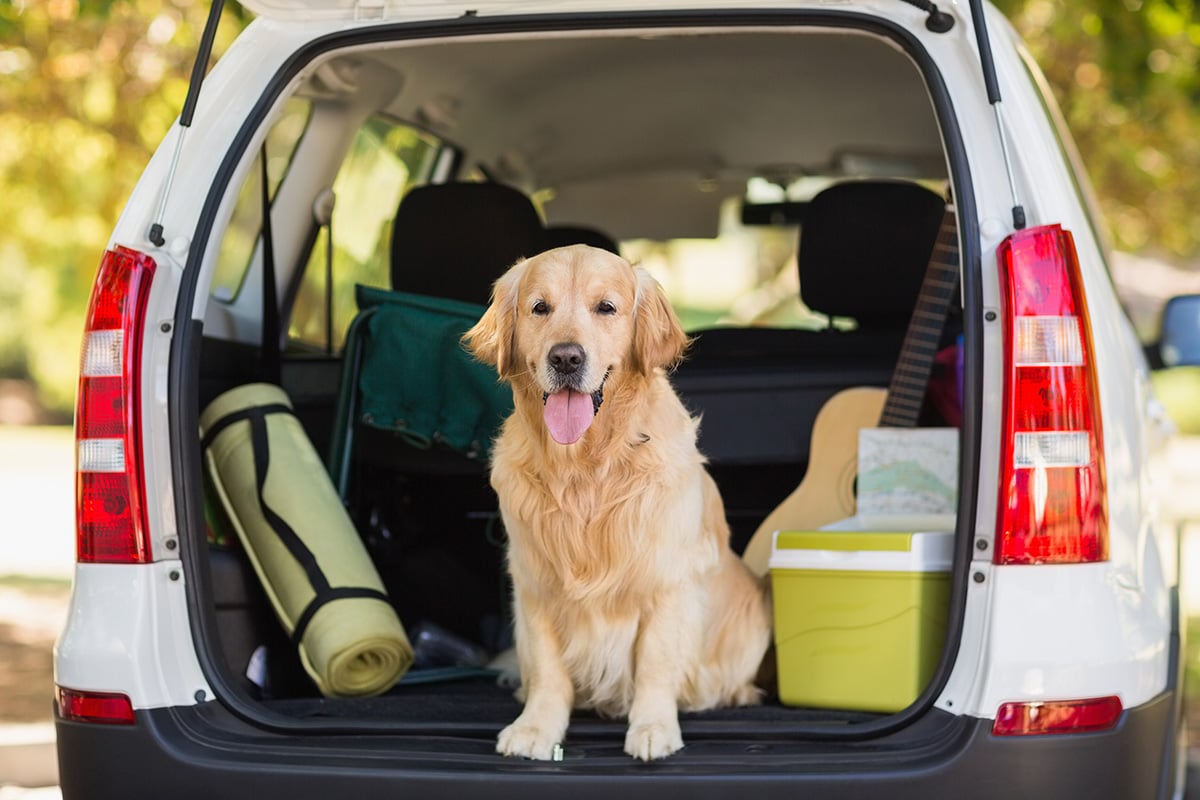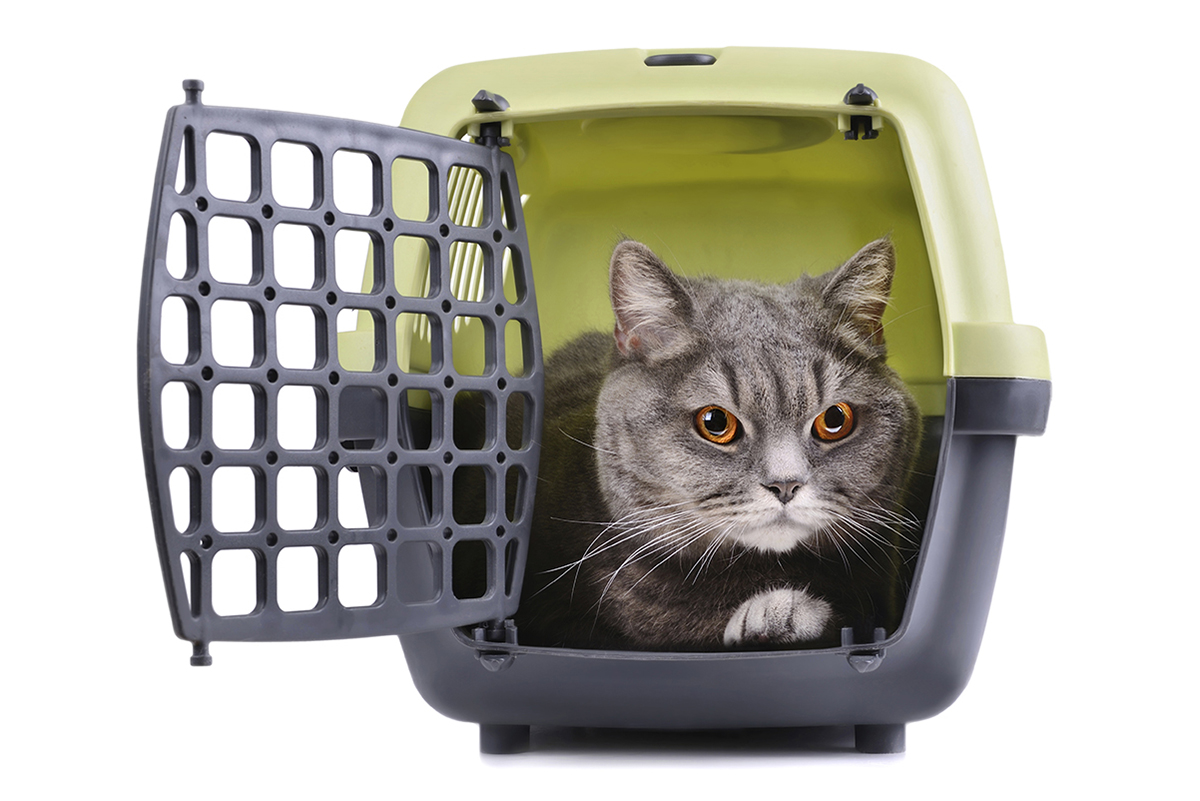Whether by plane, train, or automobile, family vacations are what memories are made of. But pet parents often face a dilemma when making their travel plans. What do you do with your beloved dog or cat when you’re heading out of town? For some, the answer is obvious: Bring them along!
If your pets are healthy, good-natured and adaptable, there’s no reason you can’t take them with you on your travels. For instance, many pets do well in the car and welcome a long road trip but it’s important, though, that you know their personality before deciding if they’ll be hardy travelers.

If your trip requires airplane travel, think carefully before bringing your pets along. Plane travel is stressful for any pet, especially if they are traveling in the cargo section. Unless it’s unavoidable, we don’t recommend it.
Advanced and careful preparation can ensure a safe and comfortable trip for everyone. Ideally, smaller pets that will easily fit in an airline regulated carrier can be placed under your seat, or the seat in front of you, during the flight. When traveling with animals it is always best to contact your specific airline directly to see what they require to insure your pet’s safety.
The key to a happy vacation is planning ahead to make sure your four-legged friend will have a happy, healthy experience regardless of the means of transportation.
First, about a week before your trip, visit your vet’s office to get your pet a clean bill of health, and to make sure they are up to date with their shots, and has received the appropriate flea, heartworm and tick repellant. “If the trip is going to be a lengthy one, bring along your pet’s medical records, especially if it has an existing medical condition,” says Dr. Mark Verdino, Senior Vice President and Chief of Veterinary Staff at North Shore Animal League America. And don’t forget to bring along medications, a recent health certificate and rabies vaccination certificates on your trip. (If you’re traveling out of the U.S., additional requirements may apply, so start the planning process months in advance.)
For anxious pets, anti-anxiety pills might provide relief, but never give your pet your own medication! “Pets should only take medicine prescribed by a veterinarian,” says Dr. Verdino.

Rubber Meets the Road: Car Safety Tips
- Breath of Fresh Air: Pets should be confined in well-ventilated travel carriers that give them plenty of room—enough to stand, sit and lay down, but not so much that they might get bumped around.
- Buckle Up for Safety: Another option is to use a dog harness designed specifically for car travel, but cats should always be kept in carriers. Although many dogs love the feeling of fresh air blowing on their fur, don’t give in. “I can’t begin to count how many times I’ve treated a dog with a scratched eye or other facial injury because they’ve been riding in cars with their heads sticking out the window,” says Dr. Verdino. “It’s incredibly dangerous.”
- Eat and Drink On the Go: Be sure to pack bottles of fresh water and some tasty treats for your pets. And don’t forget a collapsible bowl for pit stops. Also try to avoid sudden changes in their diet to prevent an upset stomach. Consistency is the key to a successful road trip with your pet.
- Bathroom Breaks: Just like us, long road trips and staying hydrated takes a toll on your pet’s bladder. Be sure to stop at designated rest areas where you can take your pet for walks on leash so they can do their business.
- NEVER Leave Your Dog Alone in the Car: Even if it’s just a quick pit stop, in a hot car your pet’s temperature can rise rapidly and they can overheat in a very short period of time. It only takes minutes to reach dangerous levels leading to heatstroke and even death.
Cats and Car Sickness: The Rules of the Road
Domestic cats are usually creatures of routine, and when that routine includes an occasional car ride they may equate it with a trip to the vet, and become anxious. The stress can cause motion sickness which is not uncommon in cats. While many dogs can be “trained” to comfortably ride in cars, it can be much more challenging for cats to overcome their anxiety. A few things to look out for when traveling in the car with your cat are excessive vocalization or howling; pacing and restlessness; excessive licking of lips or drooling; becoming lethargic; and of course, vomiting.
Cats can be de-sensitized to the trauma of car travel, it will take some work, but it can be done. Plus making your cat more comfortable in the car will be better for both of you and allow you to spend more time together.
The first step is to make them more comfortable in their carrier. Instead of taking the carrier out right before travel, teach them that the carrier is a “safe place” in your home by leaving it out several days before your trip. Perhaps near a favorite napping place or draped in a favorite blanket. Offer food and treats in the carrier. Placing the carrier on your cat’s favorite chair or even bed can help your cat become more comfortable with going in and around the carrier.
Once Fluffy is comfortable with the carrier, ease your cat’s travel anxiety by taking several short trips before embarking on a long journey. Start by simply placing your cat in the carrier inside your car, starting the motor, and sitting there without moving the car for a few minutes. The next day, repeat this process, but back out of your driveway and then return. Next, try a trip around the block. Gradually work your way up to riding comfortably for 20 to 30 minutes. Remember to offer a tasty treat, inside the carrier, for good behavior.

Up, Up and Away! Air Travel Tips
- Pets must be transported in a crate or carrier if traveling by airplane. When choosing a crate, purchase one in which your pet can lie down, stand up, sit, and circle around comfortably. Its imperative you always make sure the crate is well ventilated so your four legged friend can rest comfortably.
- Avoid crates that are too large as your pet may become injured as a result of excessive movement. Remove leashes and never muzzle your pet while traveling.
- Your pet’s name and contact information for your home and destination as well as “Live Animal” should be written on the outside of the crate. Also, make sure your pet always wears a collar with an identification tag. Breakaway collars are best for cats.
- Having a recent picture of your pet on hand, as well as a written description of your pet (name, breed, sex, age, any microchip or tattoo numbers, a description of coat, color and unusual markings, weight and height), will give you peace of mind in case you get separated from your pet during travel. This information will be vital to reuniting with your best friend in the airport.
- Tell every airline employee you come in contact with, on the ground and in the air that you are traveling with a pet in cargo. This way, they’ll be ready if any additional considerations or attention may be required.
- If the plane is delayed, or if you have any concerns about the welfare of your pet, insist that airline personnel check on the animal whenever feasible. In certain situations, removing the animal from the cargo hold and deplaning may be necessary.
Pet Friendly Accomodations
Of course, before you bring along your furry family member, make sure you’ll have a place to lay your weary heads. If you’re staying with friends, don’t assume they’ll welcome your pet without asking. For pet-friendly hotels or inns, do some research on the Internet. Many travel sites, like Expedia and Kayak.com include pet-friendly hotels. Or simply search “pet-friendly lodging” or a similar term you’ll find many options. (A caveat: Just because a Marriott in one city takes pets, that doesn’t mean every Marriott is pet-friendly. Call ahead first.)
If your pets tend to be anxious or are just real homebodies, it’s probably best to keep them safe and sound in their own surroundings. Ask a trusted friend to watch him or her, or ask your veterinarian to recommend a licensed and insured pet sitter.


